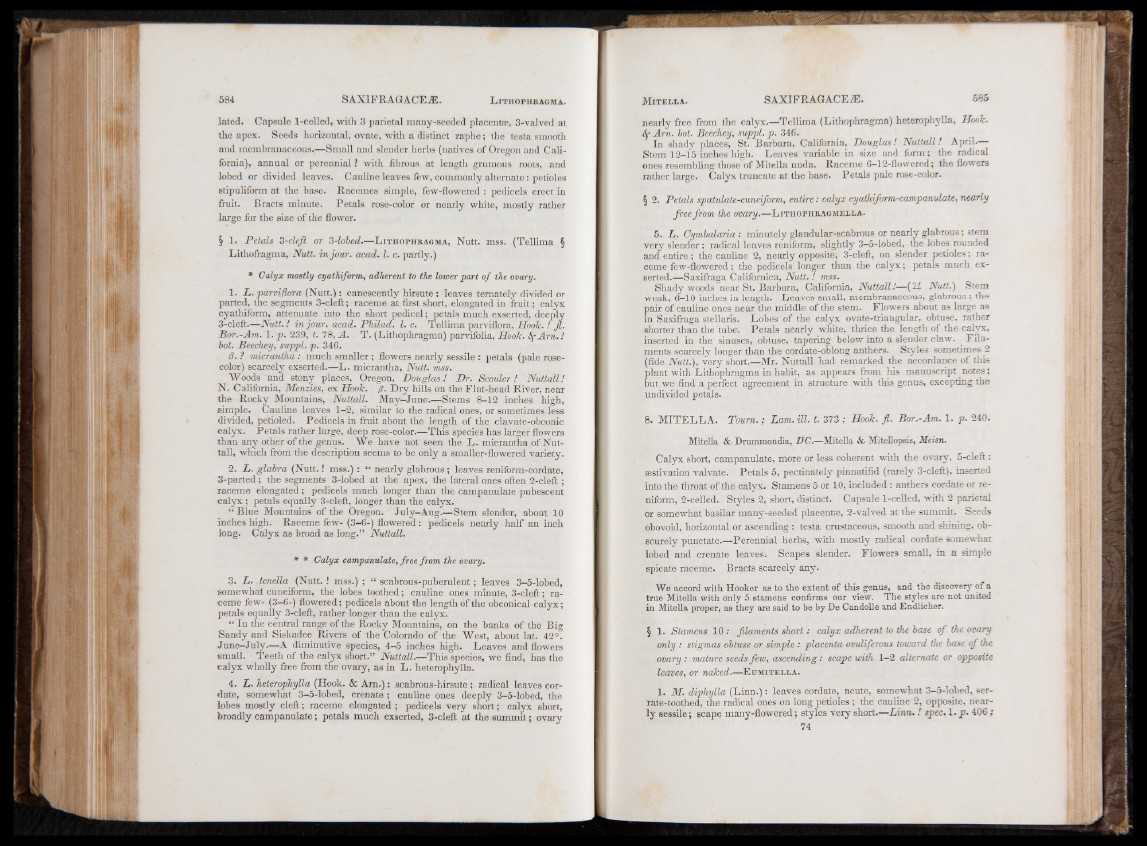
lated. Capsule 1-celled, with 3 parietal many-seeded placentas, 3-valved at
the apex. Seeds horizontal, ovate, with a distinct raphe; the testa smooth
and membranaceous..—Small and slender herbs (natives of Oregon and California),
annual or perennial ? with fibrous at length grumous roots, and
lobed or divided leaves. Cauline leaves few, commonly alternate: petioles
stipuliform at the base. Racemes simple, few-flowered : pedicels erect in
fruit. Bracts minute. Petals rose-color or nearly white, mostly rather
large for the size of the flower.
§ 1. Petals 3-cleft or 3-lobed.—L ithophragma, Nutt. mss. (Tellima §
Lithofragma, Nutt, in jour, acad. l• c. partly.)
* Calyx mostly cyathiform, adherent to the lower part of the ovary.
1. L. parviflora (Nutt.): canescently hirsute ; leaves temately divided or
parted, the segments 3-cleft; raceme at first short, elongated in fruit; calyx
cyathiform, attenuate into the short pedicel; petals much exserted, deeply
3-cleft.—Nutt.! in jour. acad. Philad. 1. c. Tellima parviflora, Hook. ! fl.
Boir.-Am. 1. p. 239, t. 78, A. T. (Lithophragma) parvifolia, Hook. SfAm.!
bot. Beechey, suppl. p. 346.
0. ? micrantha : much smaller; flowers nearly sessile : petals (pale rose-
color) scarcely exserted.—L. micrantha, Nutt. mss.
Woods and stony places, Oregon, Douglas! Dr. Scouler! Nuttall!
N. California, Menzies, ex Hook. 0. Dry hills on the Flat-head River, near
the Rocky Mountains, Nuttall. May-June.—Stems 8-12 inches high,
simple. Cauline leaves 1—2, similar to the radical ones, or sometimes less
divided, petioled. Pedicels in fruit about the length of the clavate-obconic
calyx. Petals rather large, deep rose-color.—This species has larger flowers
than any other of the genus. We have not seen the L. micrantha of Nuttall,
which from the description seems to be only a smaller-flowered variety.
2. L. glabra (Nutt.! mss.): “ nearly glabrous ; leaves reniform-cordate,
3-parted ; the segments 3-lobed at the apex, the lateral ones often 2-cleft;
raceme elongated; pedicels much longer than the campanulate pubescent
calyx; petals equally 3-cleft, longer than the calyx.
“ Blue Mountains of the Oregon. July-Aug.—Stem slender, about 10
inches high. Raceme few- (3-6-) flowered : pedicels nearly half an inch
long. Calyx as broad as long.” Nuttall.
* * Calyx campanulate, free from the ovary.
3. L. jtenella (Nutt. ! mss.) ; “ scabrous-puberulent; leaves 3-5-lobed,
somewhat cuneiform, the lobes toothed; cauline ones minute, 3-cleft; raceme
few- (3-6-) flowered; pedicels about the length of the obconical calyx;
petals equally 3-cleft, rather longer than the calyx.
“ In the central range of the Rocky Mountains, on the banks of the Big
Sandy and Siskadee Rivers of the Colorado of the West, about lat. 42°.
June—July.—A diminutive species, 4-5 inches high. Leaves and flowers
small. Teeth of the calyx short.” Nuttall.—This species, we find, has the
calyx wholly free from the ovary, as in L. heterophylla.
4. L. heterophylla (Hook. & Arn.): scabrous-hirsute ; radical leaves cordate,
somewhat 3-5-lobed, crenate ; cauline ones deeply 3-5-lobed, the
lobes mostly cleft; raceme elongated ; pedicels very short; calyx short,
broadly campanulate; petals much exserted, 3-cleft at the summit; ovary
nearly free from the calyx.—Tellima (Lithophragma) heterophylla, Hook.
8f Arn. bot. Beechey, suppl. p. 346.
In shady places, St. Barbara, California, Douglas! Nuttall! April.—
Stem 12-15 inches high. Leaves variable in size and form; the radical
ones resembling those of Mitella nuda. Raceme 6—12-flowered; the flowers
rather large. Calyx truncate at the base. Petals pale rose-color.
§ 2. Petals spatulate-cuneiform, entire: calyx cyathiform-campanulate, nearly
free from the ovary.—L it h o p h r a g m e l l a .
5. L. Cymbalaria: minutely glandular-scabrous or nearly glabrous; stem
very slender ; radical leaves reniform, slightly 3-5-lobed, the lobes rounded
and entire; the cauline 2, nearly opposite, 3-cleft, on slender petioles; raceme
few-flowered; the pedicels longer than the calyx; petals much exserted.—
Saxifraga Californica, Nutt. ! mss.
Shady woods near St. Barbara, California, Nuttall!—(2i Nutt!) Stem
weak, 6—10 inches in length. Leaves small, membranaceous, glabrous ; the
pair of cauline ones near the middle of the stem. Flowers about as large as
in Saxifraga stellaris. Lobes of the calyx ovate-triangular, obtuse, rather
shorter than the tube. Petals nearly white, thrice the length of the calyx,
inserted in the sinuses, obtuse, tapering below into a slender claw. Filaments
scarcely longer than the cordate-oblong anthers. Styles sometimes 2
(fide Nutt.), very short.—Mr. Nuttall had remarked the accordance of this
plant with Lithophragma in habit, as appears from his manuscript notes;
but we find a perfect agreement in structure with this genus, excepting the
undivided petals.
8. MITELLA. Tourn. ; Lam. ill. t. 373 ; Hook. fl. Bor.-Am. 1. p. 240.
Mitella & Drummondia, PC.—Mitella & Mitellopsis, Meisn.
Calyx short, campanulate, more or less coherent with the ovary, 5-cleft:
aestivation valvate. Petals 5, pectinately pinnatifid (rarely 3-cleft), inserted
into the throat of the calyx. Stamens 5 or 10, included : anthers cordate or reniform,
2-celled. Styles 2, short, distinct. Capsule 1-celled, with 2 parietal
or somewhat basilar many-seeded placentas, 2-valved at the summit. Seeds
obovoid, horizontal or ascending : testa crustaceous, smooth and shining, obscurely
punctate.—Perennial herbs, with mostly radical cordate somewhat
lobed and crenate leaves. Scapes slender. Flowers small, in a simple
spicate raceme. Bracts scarcely any.
We accord with Hooker as to the extent of this genus, and the discovery of a
true Mitella with only 5 stamens confirms our view. The styles are not united
in Mitella proper, as they are said to be by De Candolle and Endlicher.
§ 1. Stamens 10 : filaments short: calyx adherent to the base of the ovary
only : stigmas obtuse or simple: placenta ovuliferous toward the base of the
ovary : mature seeds few, ascending: scape viith 1—2 alternate or opposite
leaves, or naked.—E u m it e l l a .
1. M. diphylla (Linn.): leaves cordate, acute, somewhat 3-5-lobed, serrate
toothed, the radical ones on long petioles ; the cauline 2, opposite, nearly
sessile; scape many-flowered; styles very short.—L in n .! spec. 1. p. 406 ;
74